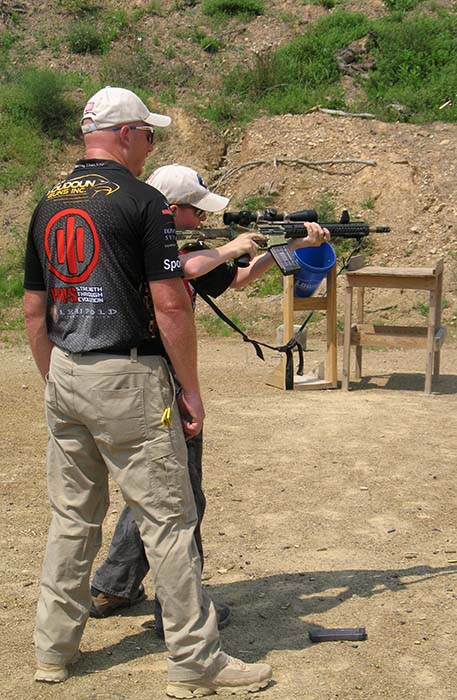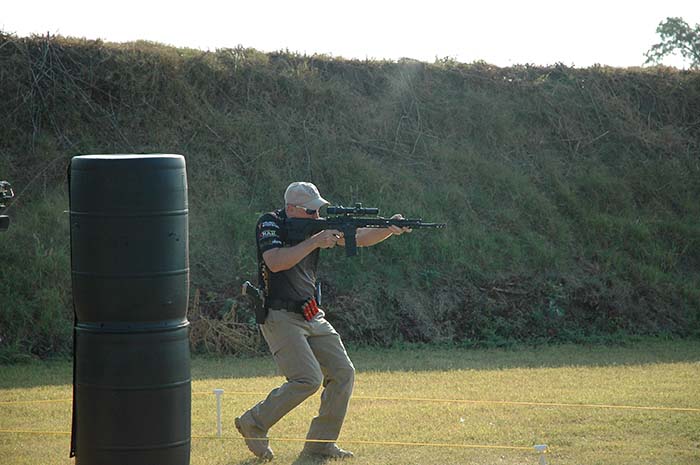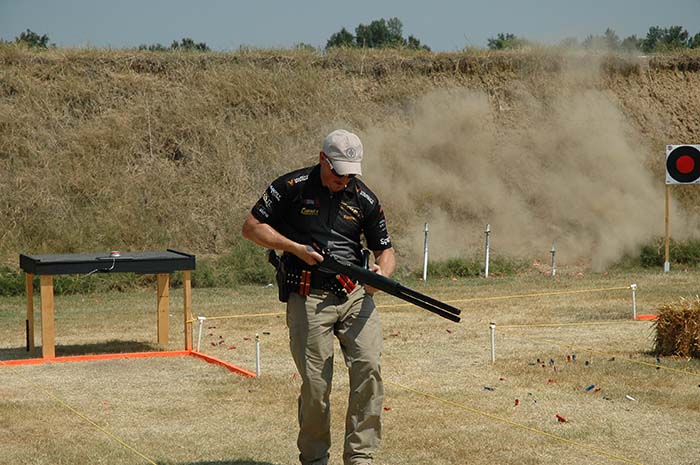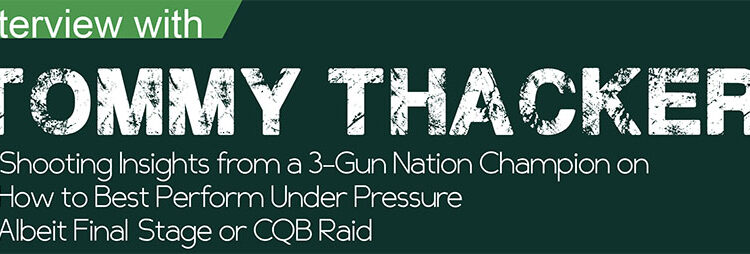By Todd Burgreen
It is safe to assume we all accept that professional competition shooters are the highest skilled “pistoleers” in the world – after all, that is what they do for a living – and get to expend time and money on improving skill levels that most just cannot imagine. It is not unheard of for certain Tier 1 Special Operation units inviting world class competition shooters to train with them in an effort to wring out any kernels of knowledge possible in running a handgun or rifle more efficiently and ruthlessly in CQB environments.
We all intuitively grasp that the practical physical aspects of shooting are the same in every realm, i.e. grip, stance, weapon manipulation, trigger operation, hand-eye speed and coordination. The biggest plus about competition is that it requires you to react quickly while running around shooting things. This is the same pattern in a CQB encounter. There are numerous articles positioning for both sides of the argument: competition can only improve performance in the tactical arena or competition has no place in an operator’s training regime. The debate continually rages over derived benefits gained from participating in “gun games” as being relevant to real world situations with many respected figures found on both sides of the argument. As with most topics the truth lies in the middle, especially after the topic gets heated and polarizes into die-hard camps. For many, competing is the best way to test abilities when under pressure without having to deal with real bullets flying in a “two-way” range environment.

Recently, SAR had the chance to discuss the topic in depth with 3-Gun National champion Tommy Thacker. Tommy’s shooting career can be traced back to 1999 at the local and regional level and by 2001 he was competing at the national level. It all started with a trip to SHOT Show in 1999 where he watched a stage demo by Team Safariland. He recorded the demo so he could practice the techniques. He would go the NRA Headquarters range in Fairfax, VA to practice. One night a few USPSA competitors saw him and told them about local USPSA matches held monthly at the NRA range; he was hooked. Tommy started working for FNH USA in 2008 and shortly thereafter formed their shooting team. Tommy considers 2009 as the year he started competing professionally. Tommy recently parted ways with FNH USA in pursuit of other endeavors. In February 2014, he took his nearly 20 years of top-level management, sales and firearms experience to ArmaLite where he was named president.
Tommy currently offers a full suite of training through Northern Virginia Tactical consisting of Basic Pistol to Advanced 3-Gun and everything in between. He has trained law enforcement (LE), military, and federal agency personnel in all levels of fundamentals to pre-deployment mission specific applications. His main goals as an instructor is to understand what student needs are as well their objectives and then help them reach these goals. Not everyone is striving to be a national champion or getting ready to deploy so an instructor needs to identify with his student to ensure they get the most out of a training segment. Below are question and answer segments that Tommy graciously participated in to give readers greater insight into shooting at a high level of performance.
SAR: What do you feel are techniques that best cross over between competition, LE, and CCW?
Thacker: Almost everything I do shooting-wise crosses over to the civilian, LE and military side of shooting; the fundamental difference is tactics. I never go into a department or agency to teach tactics, which is best left to their tactics development team. My goal is to teach them how to handle their firearms in a manner that will improve their speed and accuracy. How many chiefs/supervisors do you know that would not like to have that?
SAR: You are most associated with your 3-Gun success. Any thought to cross over into other competition styles such IDPA, IPSC, etc.?
Thacker: 3-Gun competition in my opinion is the pinnacle of the shooting sports. Top level 3-Gun competitors can step down into IDPA and USPSA and use his skill set to be competitive in those sports. However, it is more difficult for an IDPA or USPSA shooter to jump right into 3 Gun and be competitive. I shoot all of these sports exactly the same way, my shooting style does not change from a pistol match to a 3-Gun match; what changes is my tactics if you will. I know that IDPA has different rules like, use of cover, tactical order and various reloading scenarios; so I change the mindset before stepping into those types of competitions.

I see this is similar to a LE as most SWAT operators are assigned to regular patrol operations until the call comes in. When the call comes in, they have to transform to a different mindset. Their role in the stack is much different than their role on the street.
SAR: How do you get into the “zone” when getting ready to compete? How do you handle the pressure of competing in events where split seconds could make the difference?
Thacker: My “zone” for competition is probably as easy as it gets. I try to be completely relaxed. I practice this and focus on what I need to do for each part of the competition. I think this really is the key to my success, the mental game. I use one of Stephen Covey’s 7 Habits of Highly Effective People, “Begin with the End in Mind.” This is an effective tool in business and in shooting you have to know where you are going before you decide how to get there, a mistake I see often on the range.
I feel the mental preparation is just as important, if not more important, than the physical practice. Most of the top-level competitors have a skill set that is programmed at a subconscious level; there is not much in the conscious mind when they pick up the firearms to start engaging targets. I just run the program in my head; at the Pro level there is no time to think about shooting – it has to be natural as soon as the buzzer sounds.
You have to be confident in your equipment and abilities. If you are unsure of your rifle dope; a shooting position, or have never tried anything like it before you will not execute it properly. That is what practice is for, training helps your mind see and develop a memory for success. That is the key for building confidence on the range. When I walk a new course of fire, I have confidence even though I may have never been there before. The reason for the confidence is that I can almost guarantee that I have seen each little segment or array at a match or practice somewhere in the past. Our mind works with pictures and if you can remember what that array or position looked like in the past, you will be comfortable with it this time.
SAR: Can you describe in as much detail as possible your sighting process in preparation of breaking a shot?
Thacker: I wish I could tell you that I have one system that I use all the time and stick to it but unfortunately, it is not that easy. I address every target in every array a little differently. If it is a close wide-open target (0-7 yards), I get a flash sight picture, index on the target and engage because every tenth of a second counts. Again, it goes back to knowing what you are capable of and executing it properly. The sight picture varies across all three guns and for each type of target I encounter. Rifle targets vary, as some require a precise hold with the least amount of moment while others can be engaged with some movement to being on the run and drifting the sights across the target in full stride.

SAR: Recommend a structured weekly program for an already competent shooter who wants to progress to the next level?
Thacker: I would say the most important thing for a shooter to work on to help them advance to the next level is movement. If there is an opportunity to move through the course of fire and engage targets that will be the place to make up time. That being said, you could practice movement without shooting many rounds or any at all. Dry fire can be a great tool for seeing what your body is doing while you are moving. It is difficult to shoot on the move and expect to get hits if you do not know what your body does and how much your sights are moving without actually shooting. Most people just start shooting on the move and stop almost immediately because they are not hitting targets. They assume they are not ready to shoot on the move because their skill set is not there when in most cases they miss because they are trying to do something their body can’t, shooting on the move doesn’t mean running and shooting all the time. Sometimes it is just a little movement of the upper body or a small heal to toe movement and other times it can be an all-out sprint while engaging targets within 3 feet of the muzzle.
SAR: What mental preparations do you make before and during a Match?
Thacker: Ah, the question that everyone finally gets to… My mental game is my complete mindset. It is who I am and the way I live; I don’t turn on something just for competition or training. I am a very positive thinker and whole-heartedly believe there is absolutely nothing I cannot do. Your mindset is what controls your emotions and your actions. If you think negative you will be negative, if you think positive you will be a positive person and most of all, if you think you can win you will figure out a way to accomplish your goal.
I believe that God has given me a specific set of skills and qualities and has the ultimate control over my life. It is up to me to stay on the right path and not let the world drag me away from my values and principles. I know my abilities and prepare myself for each event by thinking back to the fundamentals and all of my years of training and past performances. I have a major championship and know that I can compete at the highest level of the sport and win. With that in my mind, there is nothing that scares me, nothing that shakes me and I can concentrate on the stage in front of me. Yes, the stage, not the match. If I am worried about my overall finish, I will not concentrate at the stage level and not perform at my best.
Fundamentally, you must concentrate on one thing at a time and be the best you can be at that time. Winning a match is an overall project that may consist of five to nine courses of fire; each stage is task in the overall project. Many people lose focus in a match and start to worry about other competitors overall match performance. I take that back to Covey’s “circle of concern” vs. “circle of influence.” It is okay to be aware of your “circle of concern,” or other people’s scores. However, when you spend all of your time focused in this area you will fail. On the other hand, if you spend your time focused in your “circle of influence,” or your performance, you will excel. You can only control your own performance and you can only shoot one stage at a time so there is no reason for me to look anywhere other than the current stage.
My focus is 100% on the stage I am getting ready to shoot and how I can have my best performance right there at that specific place in time. There are variables that will come into play; being tired, feeling sick; sore muscles, being hungry or distracted by any number of reasons. All of these factors will have some effect on your shooting and you must be able to identify them and adjust on the fly. If for some reason I have a bad stage, I try to let it go immediately so that it does not affect my overall match performance. Those points are lost and I cannot get them back or make them up. If I try to, that one bad stage will have a much more significant impact on my overall score. Many people will try to “make up” points on the next stage and that leads to trouble. All you can do is get back in the right mindset and do the best you can on the next stage. If you shoot to your abilities you will finish where you finish, if you try to shoot to someone else’s abilities you will beat yourself every time.
My coach reminds me all the time, “You don’t rise to the occasion; you fall to your level of training.” This is so true and I see it happen all the time at the range. Shooting is a very simple sport that we make complicated.
SAR: Thank you so much for taking the time to speak with us.. Your insights are most valuable.
Sites of Interest
Loudoun Guns, Inc.
302 Industrial CT, SE Ste F
Leesburg, VA 20175
(703) 771 7479
www.loudoungunsinc.com
Northern Virginia Tactical
(703) 677 8267
www.nvtactical.com
| This article first appeared in Small Arms Review V18N3 (June 2014) |











